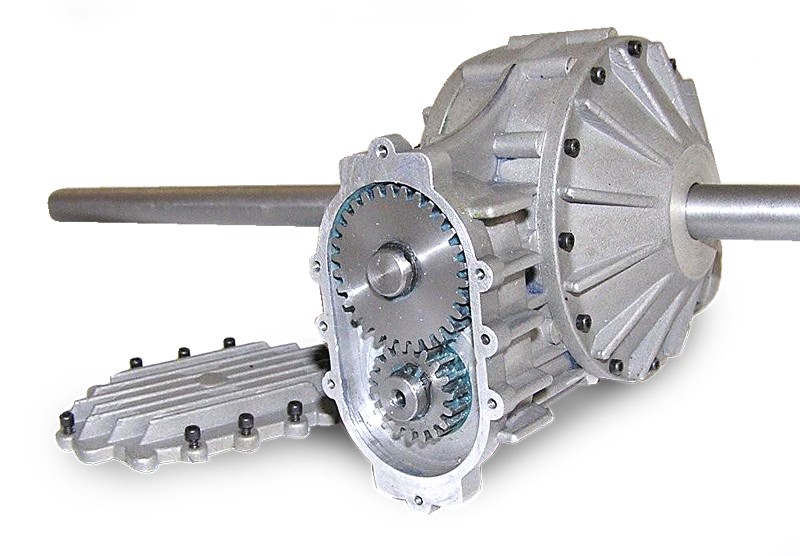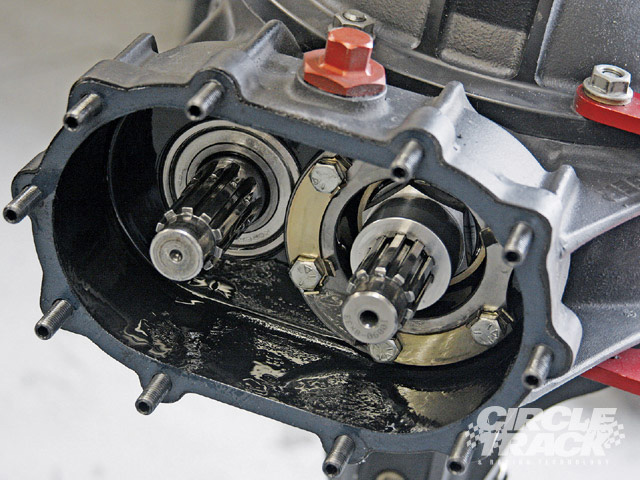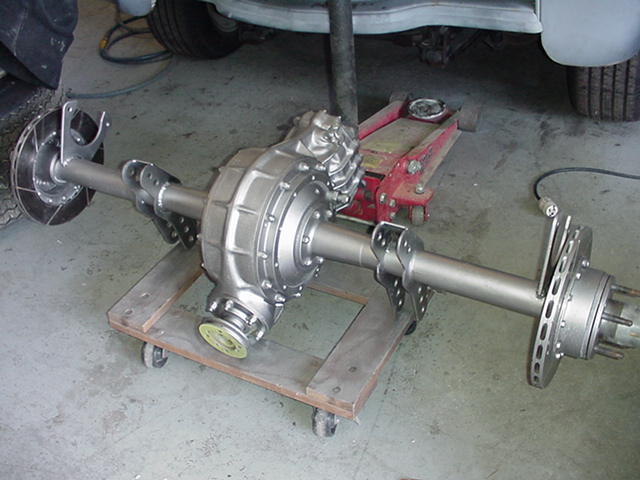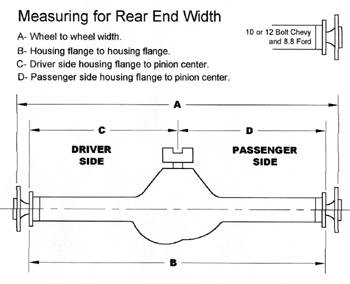halibrand
http://www.halibrand.com/rear_choice.htm
Halibrand Quick Change Rear Axle Information
Those acquainted with racing history instantly equate Halibrand Engineering with the original quick-change rear axle. Ted Halibrand designed the first lightweight, variable gear ration axle for use in most forms of performance racing. With designs dating back to 1948, Halibrand dominated Midget, Sprint, Championship, and Indy car racing sports. Halibrand designed their quick-change center section around the race popular Ford rear axle assemblies. This allowed Halibrand¡¯s center section to replace the Ford design, while utilizing the axle housings, axles, ring and pinions, differentials, and brakes readily available to the racer. The simplicity and economy coupled with Halibrand¡¯s pioneering use of magnesium casting was the secret to Halibrand¡¯s success with the race industry.
Today, you can still purchase Halibrand¡¯s V8 center section conversion kit, for a 1932 through 1948 Ford rear axle assembly. Another version is to build around a complete V8 assembly, utilizing all modern technology components, in a variety of styles and performance options. If brute strength is in your plans, our Champ quick-change rear axle assembly is the right choice for the high horsepower project. The Champ is built- around the Ford truck size rear axle assembly, utilizing 10-inch ring and pinions and heavy-duty forge axles. Like the V8 design, our Champ assembly is available in a variety of styles and performance options.
Why build your next chassis around a Halibrand quick-change?
Let¡¯s face it; most of us don¡¯t need the requirement to change gear ratios quickly. So I you¡¯re not building that new ride for a Saturday night race, where adjusting ratios for a new track is a must, then why build around a genuine Halibrand quick change?
Well, many of us still like the simplicity of swapping around the quick-change gears, for the occasional vintage race. Dialing in that ET or lap time is still easy for your streetcar, with the many gear ration sets available. Another reason is to run highway ratios on that long cruise and having the option to switch the upper change gear with the lower at your destination. In a few minutes you can switch over from a 3.48 to a 4.11 ratio with a number #3 gear set, as an example. This works equally as well with an automatic car as it does with a standard shift vehicle. Options and performance are the essence of the Hot Rod Sport; it is what drives us to build our cars in the first place, with more power and convenience than the original offered.
I hear the quick-change rear axles are noisy, why?
As stated in the opening remarks, quick-change rear end assemblies were designed around the early Fords, up through the year 1948. These Ford rear end assemblies utilized the spiral beveled hypoid designed ring and pinions. The pinion gear meshed with the ring gear t direct centerline, offering the least amount of tooth contact for a hypoid design. The hypoid design is far better than the straight bevel gears, but at centerline barely had constant tooth contact through the 360-degree rotation. Compared to the modern hypoid designs, which have the pinion meshing with the ring gear below centerline, allowing more tooth contact and achieving constant tooth contact through the 360-degree rotation. This design is utilized on the 9-inch Ford and 12-bolt Chevrolet designs today.
The constant contact below centerline ring and pinions offers the quietest and strongest rear axles today. That is why the common 9-inch Ford rear end is so popular. However, this design also utilizes more horsepower to drive, as compared with older Ford designs.
The older Ford designs by contrast were just a little noisy, even when they were brand new, hence the reason we all remember the slight whine in the 1932 through 1948 Fords. Some were quieter than others, depending on the set-up and the break-in given by the owner.
So it is understood that even a non-quick-change rear axle assembly will create some whine, but the reputation for a noisy rear axle assembly goes beyond that. The quick-change rear axle assembly has two spur gears each at the rear of the assembly connecting the driveline and the pinion. These two spur gears (also known as straight-cut gears) are the main reason a quick-change is so noisy. The spur gear design is never under constant contact and therefore, will create a resonate harmonic sound, or high-pitched whine. This doesn¡¯t bother people in the racing industry, as they understand the efficiency of centerline driven ring and pinions and spur gears that eat less horsepower. With all the other exhaust noise, the whine of the rear assembly takes low importance.
When hot rodders started using the quick-change assembly, they thought it was cool to have the whine, which symbolized a racing component. Today, a lot of hot rodders still feel the same way: they want the noise, that¡¯s just part of the culture and the traditional way. There are many ways to limit this noise through thicker gear grease and so on, but a quick-change with spur gears will be noisy, Thank You!
Halibrand recognized that some hot rodders wanted a quieter assembly, and in 1995 they introduced the helical quick-change gears to replace the spur cut gears mentioned earlier. Helical quick-change gears had been used in Sprint cars for years but many people thought this was not achievable on a streetcar. Not a problem when specifying thrust bears in the rear cover to take the end load of a helical gear. These helical gears have the teeth cut at an angle to the center of the gear. This kind of gear is useful because there is no chance of intermittent tooth-to-tooth operation, because there are at least two gears engaged at any time. This is the reason they offer a quieter operation. Many hot rodders want this option today, especially if they put a lot of road miles on their cars. Understand, the quick-change assembly fitted with helical gears will still have the common slight whine associated with the original Ford designs mentioned above. This slight noise is generally expected and of no concern to today¡¯s hot rodder. So, if you want the quietest rear assembly, go for a 9-inch Ford or 12-bolt Chevrolet design, but if you want to be cool, with that great sound of a racing car, Go Halibrand!
Why build around a genuine Halibrand quick-change rear axle assembly?
As often is the case, Halibrand quick-changes were soon discovered by hot rodders and found their way onto the American roadways. Original hot rods were built around parts readily available and where possible with performance parts. With Halibrand¡¯s dominates within the racing world, it was not surprising to see well-used Halibrand rear axles available in swap meets across America. Early hot rodders embraced the Halibrand design and built their cars around the quick-change option. This proved to be most useful for driving to the drags, switching over gear ratios and racing all day. Even if the hot rodder didn¡¯t race his car, he wanted the racing style for his ride. This early use of Halibrand¡¯s rear axles and continued preference by most chassis builders today builds value into your car. The traditional rodder¡¯s ideal rear axles and always a listed option when describing their car is proof enough on that point.
Today we would like to think our rear axle is still the favorite rear axle because of its strength, which is time-tested. We still build each rear axle to exact specifications and with the original tooling utilized by our racing version. Halibrand¡¯s Sprint car racing quick change is still the strongest available in the World of Outlaws racing circuit. We back each racing rear axle with free replacement of broken cases for the first year. We don¡¯t get many back on this warranty, even after repeated bumps and rollovers so common with Sprint car racing. Surprised? We aren¡¯t, because each Halibrand is built to win, week after week. The same strength is built into each streetcar rear axle assembly we deliver. We have taken the time to perfect our street design for its intended purpose as well. We set up each street rear axle with proper ring and pinion gear patterns to keep the rear axle on the road for a long time. Timken bearings, forged axles, best positract, strongest ring and pinions, and aerospace technology aluminum castings are utilized in all Halibrand street version rear axles.
The traditional hot rodder prefers the Halibrand design, not solely because it is the original: he selects Halibrand for its beauty in design as well. Every design feature Halibrand built into his designs was for one purpose and one purpose only: strength! The smooth design of the ribbed braces, the extra material around each bolt location, and the cooling fins built into the covers produced the vintage or classic style we embrace today in our world of hot rods. Halibrand didn¡¯t know it at the time, but he designed into each rear axle what we call the traditional style today. Be it just part of what makes a total hot rod traditional in looks, it is the style we desire today. This styling is what most hot rod manufacturers are copying today, many call it nostalgia but we call it traditional. We know because we helped write the book on traditional and are proud of our racing heritage that gave us this right.
The best builders specify genuine Halibrand because it is period perfect, allows options, builds in real value, is built strong, is traditional without question, it¡¯s today¡¯s styling preference, and it¡¯s the original rear axle. Look for the name and be sure it¡¯s a Halibrand!
http://www.south40streetrods.com/Rodsvi ... hange.html









